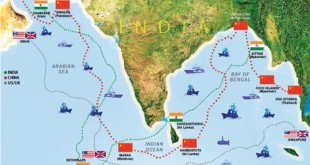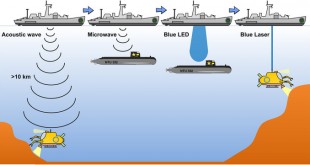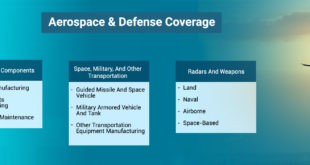The U.S. Navy Northrop Grumman MQ-4C Triton long-range maritime patrol unmanned aerial vehicle (UAV) became operational in 2018, yet the unmanned aircraft continue to evolve with upgrades and add capabilities that include signals intelligence (SIGINT) and sense-and-avoid radar.
The MQ-4C Triton Unmanned Aircraft System (UAS), is a high altitude, long endurance (HALE) aircraft that is intended to provide real-time intelligence, reconnaissance missions (ISR) over vast ocean and coastal regions, continuous maritime surveillance, as well as search and rescue missions.
The Triton will be a crucial component of the Navy’s 21st century strategy for conducting surveillance of surface ship and submarine traffic in the vast Pacific and other oceans around the globe. Tritons will work together with the Navy’s P-8A Poseidon long-range manned maritime patrol aircraft to locate and track potentially hostile surface ships and submarines. The P-8’s primary mission is anti-submarine, which makes its additional ISR role difficult to perform simultaneously, said Capt. Dan Mackin, program manager, for the Navy’s Persistent Maritime Unmanned Aircraft Systems Program Office,Mackin.
The autonomous aircraft is providing the Navy with unparalleled endurance and 360° coverage that will be able to facilitate widely expanded maritime intelligence, surveillance and reconnaissance (ISR) missions. Northrop Grumman Triton programmes vice-president Doug Shaffer said: “This aircraft represents the beginning of a new era for naval aviation.
The MQ-4C Triton aircraft can combine to fly in an orbital configuration, with one plane on station and another en route, thereby providing the US Navy with near-constant coverage of huge swaths of ocean and littorals. Navy officials have said to provide an orbit of Tritons — a 24/7 persistent ISR capability over a target — four aircraft are necessary.
The US Navy is expected to buy 68 Tritons UAS. The Royal Australian Air Force (RAAF) is expected to procure up to seven Tritons, and Japan has also been named as a potential customer. The U.S. State Department has approved Germany’s request to buy four Northrop Grumman MQ-4C Triton unmanned maritime surveillance aircraft.
MQ-4C Triton Mission capabilities
The MQ-4C is a high-altitude, long-endurance UAS suitable for conducting continuous sustained operations over an area of interest at long ranges. The UAS can be deployed in a range of missions such as maritime surveillance, battle damage assessment, port surveillance and communication relay. It will also support other units of naval aviation to conduct maritime interdiction, anti-surface warfare (ASuW), battle-space management and targeting missions.
It will provide the high-altitude, theater-spanning coverage that cues more tactically-focused the manned, land-based P-8 Poseidon aircraft and the Unmanned Carrier-Launched Airborne Surveillance & Strike (UCLASS) drone. In addition to broad-area maritime surveillance, the Triton also supports search-and-rescue missions, and assists the P-8 aircraft in anti-submarine warfare (ASW) using a variety of electro-optical sensors and a surface-search radar system. Operators of both platforms have the ability to chat and collaborate during these missions.
The Triton can descend through clouds for a closer look at ships and other targets at sea. Its sensors enable the UAV to track ships over time by gathering information on their speed, location, and type. The UAV also has basic electronic surveillance capability to monitor radar signals from ships at sea.
The MQ-4C flying as fast as 310 knots at altitudes to 60,000 feet, is capable of providing persistent maritime surveillance and reconnaissance coverage of wide oceanographic and littoral zones at a mission radius of 2,000 nautical miles. The UAS can fly 24 hours a day, seven days a week with 80% effective time on station (ETOS), will be able to cover more than 2.7 million square miles in a single mission.
The UAV will be able to fly unrefueled for nearly 10,000 nautical miles. Unlike the smaller Predator and Reaper UAVs, the Global Hawk/Triton family is not armed beyond its sophisticated suites of sensors, cameras and communications equipment
The UAS will complement the navy’s Maritime Patrol and Reconnaissance Force family of systems, delivering SIGINT (signals intelligence), C4ISR and maritime strike capabilities. It relays maritime intelligence, surveillance and reconnaissance (ISR) information directly to the maritime commander.
MQ-4C Triton operational testing
The MQ-4C, a variant of the Northrop Grumman RQ-4 Global Hawk long-range reconnaissance UAV, was designed primarily for wide-area surveillance over vast ocean areas. Compared to the Global Hawk, Triton has reinforced air frame and wing, de-icing systems, and lightning protection.
The US Navy (USN) has awarded Northrop Grumman a USD 255.3 million contract to begin low-rate initial production (LRIP) of the MQ-4C Triton maritime surveillance unmanned aerial vehicle (UAV). The contract for LRIP Lot 1, which was announced by the Department of Defense (DoD), covers three aircraft, one main control station, one forward operating station, training courseware, and tooling. According to the notification, work will be complete by the end of August 2020.
The Navy during its operational testing demonstrated its ability to share critical mission information with the manned P-8A Poseidon multi-mission maritime patrol aircraft. During a June 2, 2017 flight test at Naval Air Station Patuxent River, Md., a Triton successfully exchanged full-motion video with a Poseidon for the first time via a Common Data Link system, Naval Air Systems Command announced. The test demonstrated the Triton’s ability to track a surface target with its electro-optical/infrared (EO/IR) camera to build situational awareness for a Poseidon crew flying many miles away, further establishing the interoperability of the two aircraft that will be essential to their combined mission of controlling vast areas of ocean.
Separately, the Triton test aircraft also has conducted a series of heavy weight flight tests that will expand significantly the UAVs’ expected time on station by flying at higher altitudes with a full load of fuel, the NAVAIR statement added. The program also conducted the heavy weight tests up to the Triton’s top operational altitude of 60,000 feet.
Payloads of Northrop’s unmanned system
The payload is composed 360-degree field of regard (FOR) sensors including multifunction active sensor (MFAS) electronically steered array radar and inverse synthetic aperture radar (ISAR), electro-optical / infrared (EO/IR) sensor, automatic identification system (AIS) receiver and electronic support measures (ESM). The payload also includes communications relay equipment and Link-16.
Conventional SAR fails because the ships are usually in motion, both with a forward velocity, and other linear and angular motions that accompany sea travel. Because the target itself is moving, InverseSAR, or ISAR payloads are used for ship detection. Inverse Synthetic Aperture Radar (ISAR) is in fact SAR but also allows that the target itself is moving, and often with unknown velocities, both linear and angular. It is a much more difficult problem due to the unknown motions. ISAR is also range-Doppler imaging, but the Doppler includes target motion, too.
The Triton’s maritime search radar is called the Multi-Function Active Sensor (MFAS), and will provide the UAV with a 360-degree view of a large geographic area while providing all-weather coverage for detecting, classifying, tracking, and identifying points of interest.
Officials of the Naval Air Systems Command at Patuxent River Naval Air Station, Md., announced a $39.1 million contract modification to the Northrop Grumman Aerospace Systems sector in San Diego to enhance and adjust the Triton’s air-to-air radar, which is still in development and has not yet been test flown.
Along with the air-to-air and MFAS radar systems, the MQ-4C also will carry an electro-optical/infrared (EO/IR) sensor that will provide still imagery and full-motion video of potential threats; an electronic support measures package to identify and geolocate radar threat signals; and an Automatic Identification System (AIS) that will detect and track vessels equipped with AIS responders.
The MTS-B multispectral targeting system performs auto-target tracking and produces high resolution imagery at multiple field-of-views and full motion video. The AN/ZLQ-1 ESM uses specific emitter identification (SEI) to track and detect emitters of interest.
The Triton’s next fundamental evolution has begun, with $19.3 million order in July 2018 for Northrop Grumman to buy unique materials in preparation for outfitting the Triton with sophisticated signals intelligence (SIGINT) capability. The aim is to replace the Navy’s EP-3 manned SIGINT aircraft. The SIGINT upgrade, called Triton integrated functional capability (IFC) 4.0, is installing a SIGINT sensor payload with components from Boeing Argon ST in Fairfax, Va., and Sierra Nevada Corp. in Sparks, Nev. Navy plans call for delivering the IFC 4.0 version of the Triton UAV in 2021 to coincide with the Navy’s retirement of the EP-3. Much of the EP-3’s mission and electronic equipment is secret and is conducted in high-threat areas where long-range standoff is necessary.
Northrop Grumman and its air-to-air radar supplier, Exelis Inc. in McLean, Va., are developing a radar for the Triton that will enable the unmanned aircraft to detect other aircraft in the area for sense-and-avoid functionality, as well as for targeting. The small-but-powerful sense-and-avoid radar system shall enable the UAV not only to avoid collisions with other manned and unmanned aircraft, but also to operate safely in controlled airspace alongside commercial passenger jetliners and other aircraft. In 2016, Northrop Grumman received a $9.6 contract to install the Automatic Response Module of the Airborne Collision Avoidance System X into the MQ-4C Triton’s avionics system.
Design features
Whilst building on elements of the Global Hawk UAS, the Triton incorporates reinforcements to the airframe and wing, along with de-icing and lightning protection systems. These capabilities allow the aircraft to descend through cloud layers to gain a closer view of ships and other targets at sea when needed and will complement the P-8A Poseidon.
The main aluminium fuselage is of semi-monocoque construction, while the V-tail, engine nacelle and aft fuselage are made of composite materials. The forward fuselage is strengthened for housing sensors and the radomes are provided with lightning protection, as well as hail and bird-strike resistance.
The UAS has a length of 14.5m, height of 4.7m and a wingspan of a 39.9m. It can hold a maximum internal payload of 1,452kg and external payload of 1,089kg.
Engine and performance of the US’s UAS
MQ-4C Triton is powered by a Rolls-Royce AE3007H turbofan engine. It is an advance variant of the AE3007 engine in service with the Citation X and the Embraer Regional Jet. The engine generates a thrust of 8,500lb.
The UAS can fly at a maximum altitude of 60,000ft. It has a gross take-off weight of 14,628kg. Its maximum unrefuelled range is 9,950 nautical miles and endurance is 30 hours. The maximum speed is 357mph.
Ground control station
The UAS is operated from ground stations manned by four-men crew including an air vehicle operator, a mission commander and two sensor operators. “The UAS can fly 24 hours a day, seven days a week with 80% effective time on station (ETOS).”
The ground station includes launch and recovery element (LRE) and a mission control element (MCE). The MCE performs mission planning, launch and recovery, image processing and communications monitoring. The LRE controls related ground support equipment as well as landing and take-off operations.
References and Resources also include:
- http://www.janes.com/article/64136/dod-awards-first-lrip-contract-for-triton-uav
- https://news.usni.org/2016/06/22/triton-uav-passes-full-motion-video-p-8-flight-test
- https://www.naval-technology.com/news/us-navy-receives-mq-4c-triton-aircraft-northrop-grumman/
- https://www.militaryaerospace.com/articles/2018/07/triton-uav-upgrades.html
 International Defense Security & Technology Your trusted Source for News, Research and Analysis
International Defense Security & Technology Your trusted Source for News, Research and Analysis


